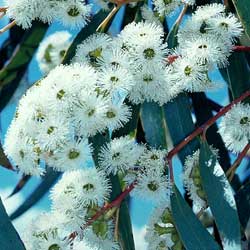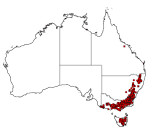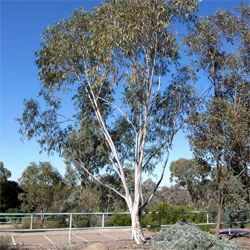Eucalyptus pauciflora
 |
Snow Gum, White Sallee
Eucalyptus pauciflora Sieber ex Spreng.
Eucalyptus pauciflora of the Myrtaceae family, a wonderful native plant with many uses whether horticulture or practical. "pauci", meaning 'few' and "florus" meaning 'flowered' is very misleading as will be shown below.
It is known mostly as Snow Gum, but also as White Sallee, Cabbage Gum, Weeping Gum or Ghost Gum. It has beautiful twisted branches and only grows to about 30 metres tall. So it’s a small to medium spreading tree. It usually has a somewhat crooked trunk and many branches with distinctive beautiful smooth green, grey and cream bark.
The leaves can be recognised as belonging to E. pauciflora even far away from the glistening in the sun from the shiny leaves. The leaves are glossy, thick and waxy with many oil glands and side veins parallel to midrib. The leaves are linear with a broad curving shape.
From October to January, the beautiful white flowers appear profusely and frequently. Its white flowers are quite attractive to people and to birds as well.
It has eleven or more simple inflorescence flowers with a scar being absent. Now you may be wondering, 'few flowers', that doesn’t look like it has only a few flowers…Well, it indeed has many flowers…How did it get this name? Well, a thirty four year old botanist from Europe, named Franz Wilhelm Sieber came over to New South Wales in 1823 for seven months. He collected as many plant species as he could and brought them back to Europe to determine what plants he had collected. Now either he collected a poorly represented specimen of E. pauciflora or in his travels home, the specimen he collected lost some of its buds and he therefore believed it to be few flowers. However, when he sold his collection only a few years later, Sprengel took hold of the specimen and in this book observed 6 florettes in the type specimen, so no one knows why it was named as few flowered. Sieber later died in 1844 at the Prague lunatic asylum.
 Eucalyptus
pauciflora is found primarily in the Snowy Mountains, right along the tablelands
in southern New South Wales through Victoria to Tasmania. It can be found in
Canberra along the original grassy plains, and in Ormond Street in Turner. It
is very long-lived and very slow growing. They take a while to establish, but
begin to grow quicker after the first few years. They are actually one of the
few eucalypts you can transplant as large specimens easily because of its fibrous
root system. It can withstand snow and ice, and prospers in well-drained soil
and colder areas, but is able to grow in diverse areas from shallow rocky soils
in very exposed dry areas to wet snowy areas on high ridge tops.
Eucalyptus
pauciflora is found primarily in the Snowy Mountains, right along the tablelands
in southern New South Wales through Victoria to Tasmania. It can be found in
Canberra along the original grassy plains, and in Ormond Street in Turner. It
is very long-lived and very slow growing. They take a while to establish, but
begin to grow quicker after the first few years. They are actually one of the
few eucalypts you can transplant as large specimens easily because of its fibrous
root system. It can withstand snow and ice, and prospers in well-drained soil
and colder areas, but is able to grow in diverse areas from shallow rocky soils
in very exposed dry areas to wet snowy areas on high ridge tops.
It can easily be cultivated from seed and can be grown as an attractive specimen tree. Its large gum-nuts also give it attractive horticulture use.
It can be used for windbreaks, shade, fence posts, fuel, honey and also for medicinal usage. There have been medical studies done on the genus Eucalyptus and it has been said to relieve congestion, prevent infections, ease muscle soreness, cure chest colds, coughs and aid in digestion. It also has a very nice scent and can be used to clear nasal passages and its essential oils can be used in soaps and shampoos. However ingesting eucalyptus oil is highly poisonous.
Text by Laura Maurice (Botanical Intern 2003)
Derivation of botanical name: Eucalyptus paucifloraEucalyptus: - a Greek compound from 'Eu', meaning 'well', and 'calyptos' or 'kalyptos', meaning 'veiled' or 'covered' alluding to the calyx and/or petals which form a lid over the flower bud; pauciflora: - from the Latin, 'pauci', meaning 'few' and 'florus' meaning 'flowered'. |
![An Australian Government Initiative [logo]](/images/austgovt_brown_90px.gif)


